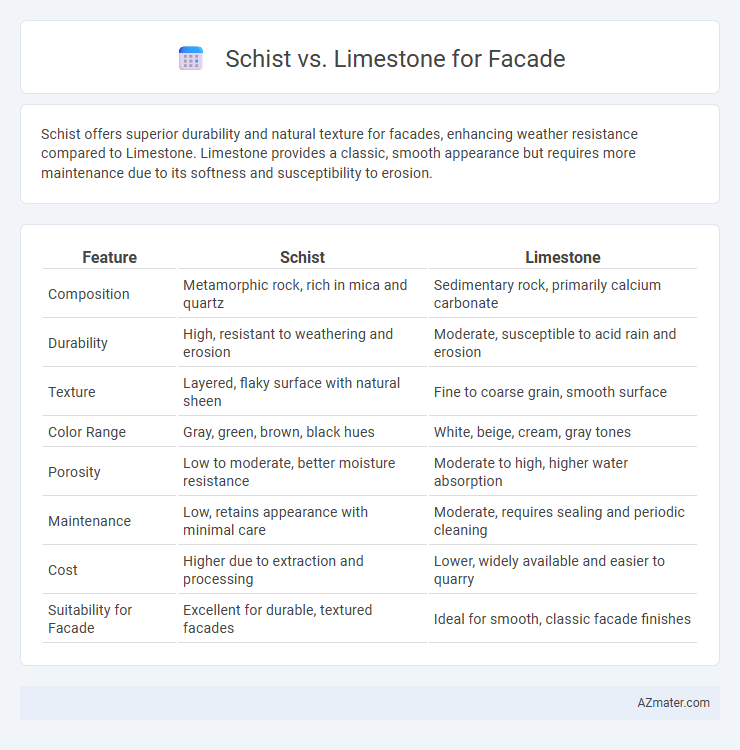Schist offers superior durability and natural texture for facades, enhancing weather resistance compared to Limestone. Limestone provides a classic, smooth appearance but requires more maintenance due to its softness and susceptibility to erosion.
Table of Comparison
| Feature | Schist | Limestone |
|---|---|---|
| Composition | Metamorphic rock, rich in mica and quartz | Sedimentary rock, primarily calcium carbonate |
| Durability | High, resistant to weathering and erosion | Moderate, susceptible to acid rain and erosion |
| Texture | Layered, flaky surface with natural sheen | Fine to coarse grain, smooth surface |
| Color Range | Gray, green, brown, black hues | White, beige, cream, gray tones |
| Porosity | Low to moderate, better moisture resistance | Moderate to high, higher water absorption |
| Maintenance | Low, retains appearance with minimal care | Moderate, requires sealing and periodic cleaning |
| Cost | Higher due to extraction and processing | Lower, widely available and easier to quarry |
| Suitability for Facade | Excellent for durable, textured facades | Ideal for smooth, classic facade finishes |
Introduction to Schist and Limestone Facades
Schist and limestone are popular materials for facades, each offering distinct aesthetic and functional qualities. Schist, a metamorphic rock with a foliated texture, provides a rugged, textured appearance and exceptional durability against weathering. Limestone, a sedimentary rock, is prized for its smooth surface, versatility in architectural styles, and ability to age gracefully with a natural patina.
Geological Origins and Composition
Schist originates from metamorphic processes, formed under intense heat and pressure that realign its mineral grains into a foliated texture dominated by mica, quartz, and feldspar, giving it a durable yet layered structure ideal for facades requiring weather resistance. Limestone, a sedimentary rock primarily composed of calcite from accumulated marine organisms' shells and skeletal fragments, offers a smoother, more uniform surface known for its natural ability to neutralize acids and its susceptibility to chemical weathering. The geological origins directly influence their facade applications: schist's foliated texture enhances aesthetic depth and durability, while limestone's carbonate composition lends a classic appearance but requires protective treatments in acidic environments.
Aesthetic Appeal and Visual Differences
Schist offers a distinctive textured surface with a natural, layered appearance that enhances rustic and contemporary facades through its shimmering, crystalline structure. Limestone provides a smooth, uniform surface with subtle color variations ranging from creamy whites to soft beiges, lending a classic, elegant look suitable for traditional and modern architecture. Visual differences are highlighted by schist's rough, variegated surface intensity versus limestone's consistent, matte finish, affecting how light interacts with each material on building exteriors.
Durability and Weather Resistance
Schist offers excellent durability and weather resistance due to its foliated texture and mineral composition, making it highly resistant to freeze-thaw cycles and erosion. Limestone, while aesthetically versatile with its smooth texture, tends to be more porous and susceptible to acid rain and weathering, which can compromise its long-term durability on facades. Choosing schist for exterior cladding ensures enhanced structural integrity and longevity in harsh environmental conditions compared to limestone.
Insulation and Energy Efficiency
Schist offers superior thermal insulation due to its dense, foliated structure, which reduces heat transfer and enhances energy efficiency in building facades. Limestone, while aesthetically appealing and widely used, has higher thermal conductivity, making it less effective in insulating against temperature fluctuations. Choosing schist for facade cladding can significantly improve a building's energy performance by maintaining stable indoor temperatures and reducing heating and cooling costs.
Installation and Maintenance Requirements
Schist offers easier installation due to its natural cleft surface, allowing for straightforward anchoring and less cutting compared to the dense, homogenous structure of limestone which requires specialized tools and skilled labor. Maintenance of schist is typically lower because its rough texture hides dirt and minor damages, whereas limestone demands frequent cleaning and sealing to prevent staining and weathering. Both materials benefit from periodic inspections, but limestone's susceptibility to acid rain and erosion necessitates more vigilant upkeep to preserve its facade integrity.
Cost Comparison and Budget Considerations
Schist typically costs more than limestone due to its natural durability and unique texture, which can increase both material and installation expenses. Limestone offers a more budget-friendly option with moderate maintenance needs, making it attractive for large-scale or cost-sensitive facade projects. When planning the budget, consider long-term costs including weather resistance and potential repairs, as schist's resilience may reduce future expenditures compared to limestone.
Environmental Impact and Sustainability
Schist offers higher durability and weather resistance, reducing the need for frequent replacement and minimizing resource consumption over time compared to limestone. Limestone quarrying generates significant carbon emissions and can lead to habitat destruction, while schist extraction typically has a lower environmental footprint due to less invasive mining methods. Choosing schist for facades supports sustainability goals by enhancing building longevity and reducing carbon emissions associated with maintenance and material sourcing.
Popular Applications in Modern Architecture
Schist and limestone are widely used facade materials in modern architecture, each offering distinct aesthetic and functional benefits. Schist's natural layered texture and durability make it popular for creating rugged, organic exteriors in residential and commercial buildings, while limestone's smooth surface and versatility suit contemporary designs requiring elegance and timeless appeal. Architects often choose schist for eco-friendly projects and limestone for historic or institutional structures, reflecting their unique applications in enhancing building facades.
Choosing the Right Stone for Your Facade
Schist offers a natural, rugged texture with excellent durability and weather resistance, making it ideal for rustic or modern facades. Limestone provides a smooth, elegant appearance with superior workability but requires regular maintenance to prevent erosion and staining. Selecting between schist and limestone depends on desired aesthetic, climate conditions, and long-term upkeep commitments for your building's facade.

Infographic: Schist vs Limestone for Facade
 azmater.com
azmater.com